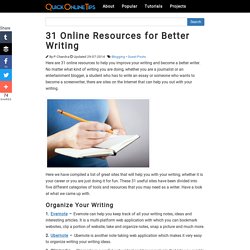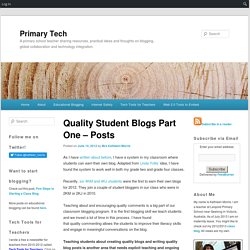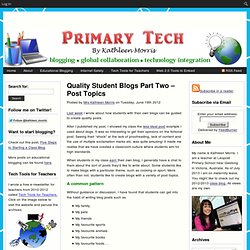

Story Starters for Kids. Publishing Learners' Writing. Light summer dresses beckon behind the door as the sun finds its path through slanted shades.

Memories of green, playgrounds and crystal clear seas entice my mind. However, being an educator, summer is a time when I catch up on professional training, academic studies and research. It is also a time which allows me to look into learning tools with more leisure, playing with assumptions of what may most interest students in coming semesters.
With the regular bandwagon terminology regarding E-learning, learning, ways of learning is often on my mind. Social Learning? Whether through games and gaming, virtual worlds or tools which challenge one's creativity and organisational skills, there is something for everyone. One motivational approach is to have learners publish their own work, whether class work, a project or a topic they are interested in and may share with others. 31 Online Resources for Better Writing. Here are 31 online resources to help you improve your writing and become a better writer.

No matter what kind of writing you are doing, whether you are a journalist or an entertainment blogger, a student who has to write an essay or someone who wants to become a screenwriter, there are sites on the Internet that can help you out with your writing. Here we have compiled a list of great sites that will help you with your writing, whether it is your career or you are just doing it for fun. These 31 useful sites have been divided into five different categories of tools and resources that you may need as a writer.
iPads can’t improve learning without good teaching Pt 2 – Writing. Used with permission from Debbie Ridpath Ohi at Inkygirl.com ( ) Writing and technology has been a controversial subject for many traditionalists in education. “Spell check stops children from learning to spell”. “All students do today is copy and paste from Wikipedia and Google searched articles.” ” Children need to handwrite all their drafts”. “William Shakespeare didn’t have a laptop” ( OK, i just threw that in for fun!) At the same time, of course, as a teacher I have been subjected to countless reports and stories typed in ridiculous unreadable coloured fonts, decorated with superfluous clip art and WordArt headings and thousands of “death by Powerpoints” unnecessarily printed out to hand up to me. 20 years of computers as a publishing tool has not necessarily improved the standard of students’ writing skills.
The key words in that last sentence are of course publishing and writing. Which leads me once more to the star of “Mr G Online”, the iPad. What is writing? Paper Rater: Free Online Grammar Checker, Proofreader, and More. Boom Writer. BoomWriter lets you easily incorporate and experience the benefits of technology as your students are engaged in the following (or similar) standards-based learning activities: Grade 3 CCSS.ELA-Literacy.W.3.3 - Write narratives to develop real or imagined experiences or events using effective technique, descriptive details, and clear event sequences.

Using BoomWriter’s feature allowing teachers to create their own story start, students collaboratively create imagined multi-paragraph personal narratives using a teacher generated prompt (e.g. “When I woke up on Saturday morning, I had no idea I was in for the craziest day of my entire life…”). Grade 5 CCSS.ELA-Literacy.RL.5.2 - Determine a theme of a story, drama, or poem from details in the text, including how characters in a story or drama respond to challenges or how the speaker in a poem reflects upon a topic; summarize the text. Grade 6. Quality Student Blogs Part One – Posts. As I have written about before, I have a system in my classroom where students can earn their own blog.

Adapted from Linda Yollis’ idea, I have found the system to work well in both my grade two and grade four classes. Recently, six 4KM and 4KJ students were the first to earn their own blogs for 2012. They join a couple of student bloggers in our class who were in 2KM or 2KJ in 2010. Teaching about and encouraging quality comments is a big part of our classroom blogging program. It is the first blogging skill we teach students and we invest a lot of time in this process. Teaching students about creating quality blogs and writing quality blog posts is another area that needs explicit teaching and ongoing feedback. Quality Student Blogs Part Two – Post Topics. Posted by Mrs Kathleen Morris on Tuesday, June 19th 2012 Last week I wrote about how students with their own blogs can be guided to create quality posts.

After I published my post, I showed my class the less ideal post example I used about dogs. It was so interesting to get their opinions on the fictional post. Seeing their “shock” at the lack of proofreading, lack of content and the use of multiple exclamation marks etc. was quite amusing! It made me realise that we have created a classroom culture where students aim for high standards. When students in my class earn their own blog, I generally have a chat to them about the sort of posts they’d like to write about.